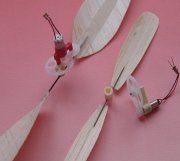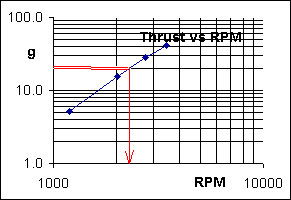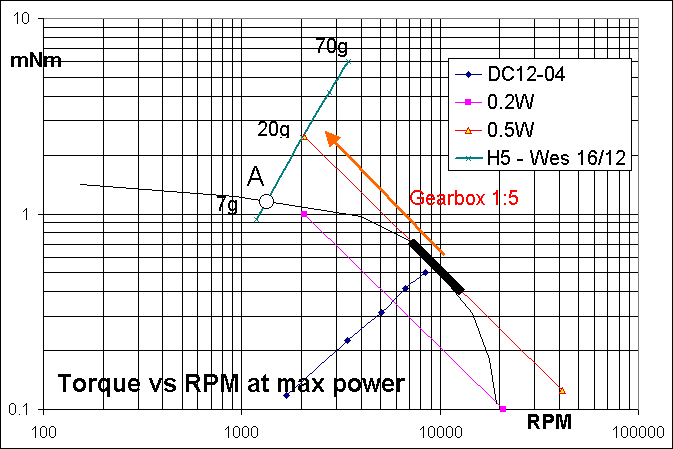Propellers for Slow-flyers:
Selection guide
| This document explains how to match a motor and a propeller.
Since documentation on motors and propellers is rather scarce, and
home made propellers rather easy to do, a setup for measuring propellers,
as described in the propeller measure document, is strongly recommended.
Any good coreless motor, about two times more powerfull than the motors
you plan to use and of known torque constant k, can be used for this
purpose. The frequency meter can be an expensive lab instrument, the
multipurpose frequency/counter DIDEL is developing or some electronic
kit. |

|
Example
Let us take an example with well known slow flyers components, the DC5-2.4
motor and the 16/12 carbon propeller, both from Wes Technik.
| Let us say we need 20g of thrust. The Thrust vs RPM of
prop 16/12 is repeated next, and shows we need a rotation speed
of about 2300 RPM.. We can also see on the specs the corresponding
power is about 1W. The DC5.2.4 can fit. |
 |
Now we represent on the same plot the Torque/RPM characteristics of these
two components, as measured (see DC5-2.4
and prop 16/12)

The two curves clearly do not match. There are three solutions:
| 1 |
Put anyway the propeller on the motor shaft. The result
will be the motor will work at point A, along its constant voltage
torque to RPM curve (the one which is straight on linear plots). The
thrust will be reduced to 7g, since the motor works far from ist maximum
power point |
| 2 |
Change the propeller for a smaller one that will spin
faster. Since the RPM ratio is about 5, the propeller diameter should
be divided by the square root of 5, and the power will be increased
by the same ratio. But the propeller will not be as efficient and
you may get only 10g of thrust |
| 3 |
Add a gearbox with a 1:5 ratio, that will divide the
rotation speed by 5, and increase the torque by about the same value.
A small loss of power will result from the gear train. Both the motor
and the propeller will be efficient. |
Thrust to power estimation
In the matching process, the first step is to define what power is required
for a given thrust.
-- to be continued soon or later --
|